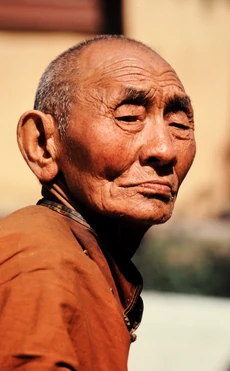|
Part of a series on Tibetan Buddhism | |
|---|---|
| History | |
| Timeline · Related-topics | |
| Schools | |
| Nyingma · Kagyu · Sakya · Gelug · Bön | |
| Key Concepts | |
| Three marks of existence · Skandha · Cosmology · Saṃsāra · Rebirth · Bodhisattva · Dharma · Dependent Origination · Karma | |
| Major Figures | |
| Gautama Buddha · Padmasambhava · Je Tsongkhapa · Dalai Lama · Panchen Lama · Lama · Karmapa Lama · Rinpoche · Geshe · Terton · Tulku | |
| Buddhahood · Avalokiteśvara · Four Stages of Enlightenment · Tantric yoga · Paramitas · Meditation · Laity | |
|
Major Monasteries | |
| Changzhug · Drepung · Dzogchen · Ganden · Jokhang · Kumbum · Labrang · Mindroling · Namgyal · Narthang · Nechung · Pabonka · Palcho · Ralung · Ramoche · Sakya · Sanga · Sera · Shalu · Tashilhunpo · Tsurphu · Yerpa | |
| Chotrul Duchen · Dajyur · Losar · Monlam · Sho Dun | |
| Texts | |
| Kangyur · Tengyur · Tibetan Canon · Mahayana Sutras | |
|
Art | |
| Sand mandala · Thangka · Ashtamangala · Tree of physiology | |
|
Outline · Comparative Studies · Culture · List of topics · Portal | |

Mongolian Lama
Lama (Tibetan: བླ་མ་; Wylie: bla-ma) is a title for a Tibetan teacher of the Dharma. The name is similar to the Sanskrit term guru (see Tibetan Buddhism and Bön). The title can be used as an honorific title conferred on a monk, nun or (in the Nyingma, Kagyu and Sakya schools) advanced tantric practitioner to designate a level of spiritual attainment and authority to teach, or may be part of a title such as Dalai Lama or Panchen Lama applied to a lineage of reincarnate lamas (Tulkus).
Perhaps due to misunderstandings by early western scholars attempting to understand Tibetan Buddhism, the term Lama has historically been erroneously applied to Tibetan monks generally. Similarly, Tibetan Buddhism was referred to as Lamaism by early western scholars and travelers who did not understand that what they were witnessing was a form of Buddhism; they may also have been unaware of the distinction between Tibetan Buddhism and Bön. The term Lamaism is now considered derogatory.[1]
In the Vajrayana practice path of Tibetan Buddhism, the lama is often the tantric spiritual guide, the guru to the aspiring Buddhist yogi or yogini. As such, the lama will then appear as one of the Three Roots (a variant of the Three Jewels), alongside the yidam and protector (who may be a dakini, dharmapala or other Buddhist deity figure).
See also[]
- See Category:Lamas for a list of Tibetan Buddhist teachers.
References[]
- ↑ Korom, Frank J. (1997). "Constructing Tibetan Culture: Contemporary Perspectives". World Heritage Press.
| This page uses content from the English Wikipedia. The original article was at Lama. The list of authors can be seen in the page history. |
